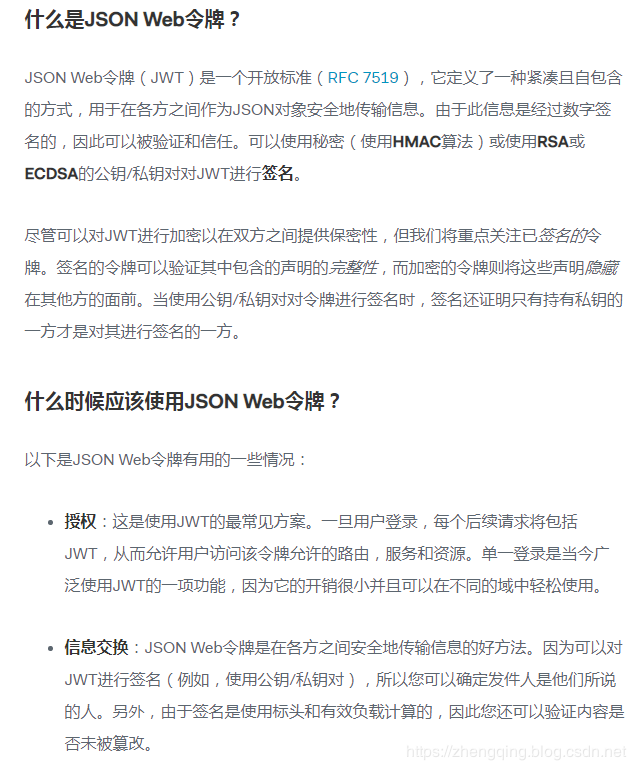一、前言
本篇文章将讲述Spring Security 简单整合JWT 处理认证授权
基本环境
- spring-boot 2.1.8
- mybatis-plus 2.2.0
- mysql 数据库
- maven项目
Spring Security入门学习可参考之前文章:
- SpringBoot集成Spring Security入门体验(一)
https://blog.csdn.net/qq_38225558/article/details/101754743 - Spring Security 自定义登录认证(二)
https://blog.csdn.net/qq_38225558/article/details/102542072 - Spring Security 动态url权限控制(三)
https://blog.csdn.net/qq_38225558/article/details/102637637
二、 Spring Security 简单整合 JWT
有关JWT不了解的可以看下官网文档:https://jwt.io/introduction/

1、引入jwt依赖
<!-- jwt依赖: https://mvnrepository.com/artifact/io.jsonwebtoken/jjwt -->
<dependency>
<groupId>io.jsonwebtoken</groupId>
<artifactId>jjwt</artifactId>
<version>0.9.1</version>
</dependency>
2、在Security登录认证成功后生成jwt令牌返回给前端保存
jwt生成令牌代码如下:
// 生成jwt访问令牌
String jwtToken = Jwts.builder()
// 用户角色
.claim("ROLE_LOGIN", "ADMIN")
// 主题 - 存用户名
.setSubject("张三")
// 过期时间 - 30分钟
.setExpiration(new Date(System.currentTimeMillis() + 30 * 60 * 1000))
// 加密算法和密钥
.signWith(SignatureAlgorithm.HS512, "helloworld")
.compact();
这里贴出小编文末案例demo源码中关于登录认证处理中的使用
@Component
public class AdminAuthenticationProvider implements AuthenticationProvider {
@Autowired
UserDetailsServiceImpl userDetailsService;
@Autowired
private UserMapper userMapper;
@Override
public Authentication authenticate(Authentication authentication) throws AuthenticationException {
// 获取前端表单中输入后返回的用户名、密码
String userName = (String) authentication.getPrincipal();
String password = (String) authentication.getCredentials();
SecurityUser userInfo = (SecurityUser) userDetailsService.loadUserByUsername(userName);
boolean isValid = PasswordUtils.isValidPassword(password, userInfo.getPassword(), userInfo.getCurrentUserInfo().getSalt());
// 验证密码
if (!isValid) {
throw new BadCredentialsException("密码错误!");
}
// 前后端分离情况下 处理逻辑...
// 更新登录令牌
// 当前用户所拥有角色代码
String roleCodes = userInfo.getRoleCodes();
// 生成jwt访问令牌
String jwt = Jwts.builder()
// 用户角色
.claim(Constants.ROLE_LOGIN, roleCodes)
// 主题 - 存用户名
.setSubject(authentication.getName())
// 过期时间 - 30分钟
.setExpiration(new Date(System.currentTimeMillis() + 30 * 60 * 1000))
// 加密算法和密钥
.signWith(SignatureAlgorithm.HS512, Constants.SALT)
.compact();
User user = userMapper.selectById(userInfo.getCurrentUserInfo().getId());
user.setToken(jwt);
userMapper.updateById(user);
userInfo.getCurrentUserInfo().setToken(jwt);
return new UsernamePasswordAuthenticationToken(userInfo, password, userInfo.getAuthorities());
}
@Override
public boolean supports(Class<?> aClass) {
return true;
}
}
前端页面保存的jwt令牌格式如下:

3、Security访问鉴权中认证用户信息
我们在访问每一个url请求的时候,在统一认证的地方获取jwt中我们需要的信息然后认证即可,【注: Claims 中存放着我们需要的信息】
例如: 我们可以将用户名、密码存放jwt中,然后在认证的时候读取到其中的用户信息,然后查询数据库认证用户,如果满足条件即成功访问,如果不满足条件即抛出异常处理
温馨小提示:如果jwt令牌过期,会抛出
ExpiredJwtException异常,我们需要拦截到,然后交给认证失败处理器中处理,然后返回给前端,这里根据个人业务实际处理即可~
// 获取jwt中的信息
Claims claims = Jwts.parser().setSigningKey("helloworld").parseClaimsJws(jwtToken.replace("Bearer", "")).getBody();
// 获取当前登录用户名
System.out.println("获取当前登录用户名: " + claims.getSubject());
小编项目中认证过滤器中的使用如下:
@Slf4j
@Component
public class MyAuthenticationFilter extends OncePerRequestFilter {
@Autowired
AdminAuthenticationEntryPoint authenticationEntryPoint;
private final UserDetailsServiceImpl userDetailsService;
protected MyAuthenticationFilter(UserDetailsServiceImpl userDetailsService) {
this.userDetailsService = userDetailsService;
}
@Override
protected void doFilterInternal(HttpServletRequest request, HttpServletResponse response, FilterChain filterChain) throws ServletException, IOException {
MultiReadHttpServletRequest wrappedRequest = new MultiReadHttpServletRequest(request);
MultiReadHttpServletResponse wrappedResponse = new MultiReadHttpServletResponse(response);
StopWatch stopWatch = new StopWatch();
try {
stopWatch.start();
// 前后端分离情况下,前端登录后将token储存在cookie中,每次访问接口时通过token去拿用户权限
String jwtToken = wrappedRequest.getHeader(Constants.REQUEST_HEADER);
log.debug("后台检查令牌:{}", jwtToken);
if (StringUtils.isNotBlank(jwtToken)) {
// JWT相关start ===========================================
// 获取jwt中的信息
Claims claims = Jwts.parser().setSigningKey(Constants.SALT).parseClaimsJws(jwtToken.replace("Bearer", "")).getBody();
// 获取当前登录用户名
System.out.println("获取当前登录用户名: " + claims.getSubject());
// TODO 如需使用jwt特性在此做处理~
// JWT相关end ===========================================
// 检查token
SecurityUser securityUser = userDetailsService.getUserByToken(jwtToken);
if (securityUser == null || securityUser.getCurrentUserInfo() == null) {
throw new BadCredentialsException("TOKEN已过期,请重新登录!");
}
UsernamePasswordAuthenticationToken authentication = new UsernamePasswordAuthenticationToken(securityUser, null, securityUser.getAuthorities());
// 全局注入角色权限信息和登录用户基本信息
SecurityContextHolder.getContext().setAuthentication(authentication);
}
filterChain.doFilter(wrappedRequest, wrappedResponse);
} catch (ExpiredJwtException e) {
// jwt令牌过期
SecurityContextHolder.clearContext();
this.authenticationEntryPoint.commence(wrappedRequest, response, null);
} catch (AuthenticationException e) {
SecurityContextHolder.clearContext();
this.authenticationEntryPoint.commence(wrappedRequest, response, e);
} finally {
stopWatch.stop();
}
}
}
简单的入门使用就是这样了
三、总结
- 引入
jwt依赖 - 登录系统成功后
生成jwt令牌返回给前端保存到浏览器请求头中 - 在每一次请求访问系统url时,在统一认证过滤器中获取到请求头中jwt令牌中保存的
用户信息然后做认证处理,如果满足条件成功访问,如果不满足交给认证失败处理器返回指定内容给前端


 posted on
posted on

 浙公网安备 33010602011771号
浙公网安备 33010602011771号